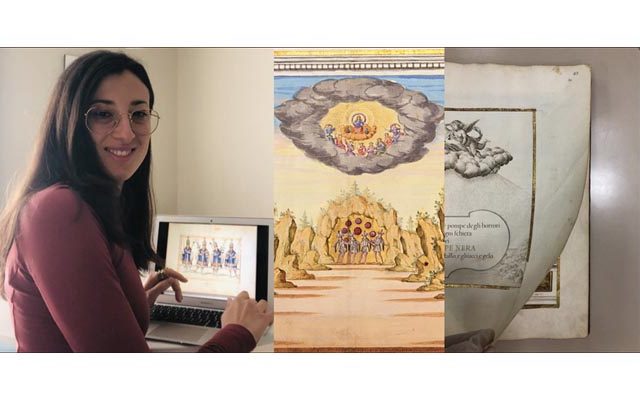
In 2018–19 I had the pleasure of working at the Clark Library as an Ahmanson-Getty Postdoctoral Fellow for the Core Program “Making Worlds: Art, Materiality, and Early Modern Globalization,” organized by Angela Vanhaelen and Bronwen Wilson. I moved from the University of Venice–Ca’ Foscari, where I completed my PhD, to UCLA to explore the integration and translation of sweeping and fine-grained transcultural motifs and influences in European ballets from the seventeenth century. Focusing my analysis on the extant textual and visual sources–preparatory drawings, prints in commemorative volumes–I examined dancers’ costumes and movements, landscapes, and commodities on stage. The case-study with which I engaged for the Core program was Il Tabacco, a ballet staged in Turin for Christine of Bourbon-France in 1650. Christine was regent of the Savoy Duchy from the death of her husband in 1637 until her son’s majority in 1648. However, she unofficially retained power until her death in 1663. A lavish album today held at the National Library in Turin documents this spectacle: the drawings, in ink and gouache with silver and gold accents, take the viewers on a journey following in the footsteps of tobacco as it moves through the world. Figures from the Americas to the Middle East caught in the act of preparing and consuming this commodity reanimate the dynamic movements of the dancers on stage. Bringing the formal analysis of this source together with a wide range of literary records held at the Clark Library–as The Smoaking Age by Richard Brathwaite, published in London in 1617–my task has been to demonstrate how this event told the story of a semantically unstable commodity, a sacred social institution among American natives that became an economic institution, desacralized and alienable, on the other shores of the Atlantic. This paper is now a chapter for the forthcoming volume Making Worlds: Global Invention in the Early Modern Period (edited by Angela Vanhaelen and Bronwen Wilson, University of Toronto Press, 2023).
This study paved the way for the beginning of another research journey. Indeed, my current project “ANIMATE – Animation, Materials, Transcultural Ecologies: Performing Worlds at the Baroque Savoy Court of Christine of France” stems from that research. Presented with the University of Bologna as host institution and UCLA as partner institution, it has been awarded a fellowship within the Marie Skłodowska-Curie Actions (MSCA) scheme in Social Sciences and Humanities, funded by the European Commission. The ballet, Il Tabacco, attests to crucial and timely insights to be obtained from examining natural resources, landscapes, and stagecrafts viewers would have seen in the spectacles staged during Christine’s lifetime. It provided a strong foundation for expanding my research to embrace all the Savoy performances, in order to shed light on the global, economic, and ecological environment to which such critical instances responded. Fourteen albums (over 1,117 manuscript pages) realized by calligrapher, cartographer, and engineer Giovanni Tommaso Borgonio document these events in all their constituent elements: a world populated by Caribbean divers fishing for pearls in seascapes enclosed “in the small borders of a room,” or miniaturized Alpine mountains laden with imaginary veins of gold and minerals, are just two examples. “ANIMATE” probes two critical and imbricated issues raised by these spectacles: how they performed the conversion of natural resources into lucrative items with high economic and tax-yielding significance, and how the scenery’s landscapes and waterscapes attested to the transformation and exploitation of the terrestrial and oceanic environments to or from which these products were grown or extracted, transported, and imported. By exploring Borgonio’s drawings, I construe these elaborate performances as a critical laboratory for thinking through the complexities of early modern global forces, the economic circulation they incited and the consequences on the landscapes they impacted. Last fall I had the opportunity to carry on a part of this project–with a specific spotlight on how tobacco, gold, and pearls were embedded in these narrations–as Berenson Fellow at Villa I Tatti, The Harvard Center for Italian Renaissance Studies. “ANIMATE” is a three-year research project conducted at the Department of Art History at UCLA 2022 –2023, andat the Department of Italian Studies at the University of Bologna in 2024.
Intellectual exchanges through the year at the Clark & Center, and during the three conferences of the Core program, have been especially crucial for understanding the relevance of my research to present day concerns–ecological changes and challenges around the acquisition of raw materials are particularly important considerations of the MSCA scheme. As part of this project, I will have the opportunity to organize teaching and research activities, including two seminars, a workshop, and a symposium at the Clark & Center and in the Art History Department, while also preparing my first monograph. To be back within UCLA’s vibrant academic environment and network of students, staff, and faculty is energizing.
–Elisa Antonietta Daniele
ANIMATE has received funding from the EU’s Horizon 2020 research and innovation program under the Marie Sklodowska-Curie grant agreement No 101025547.

